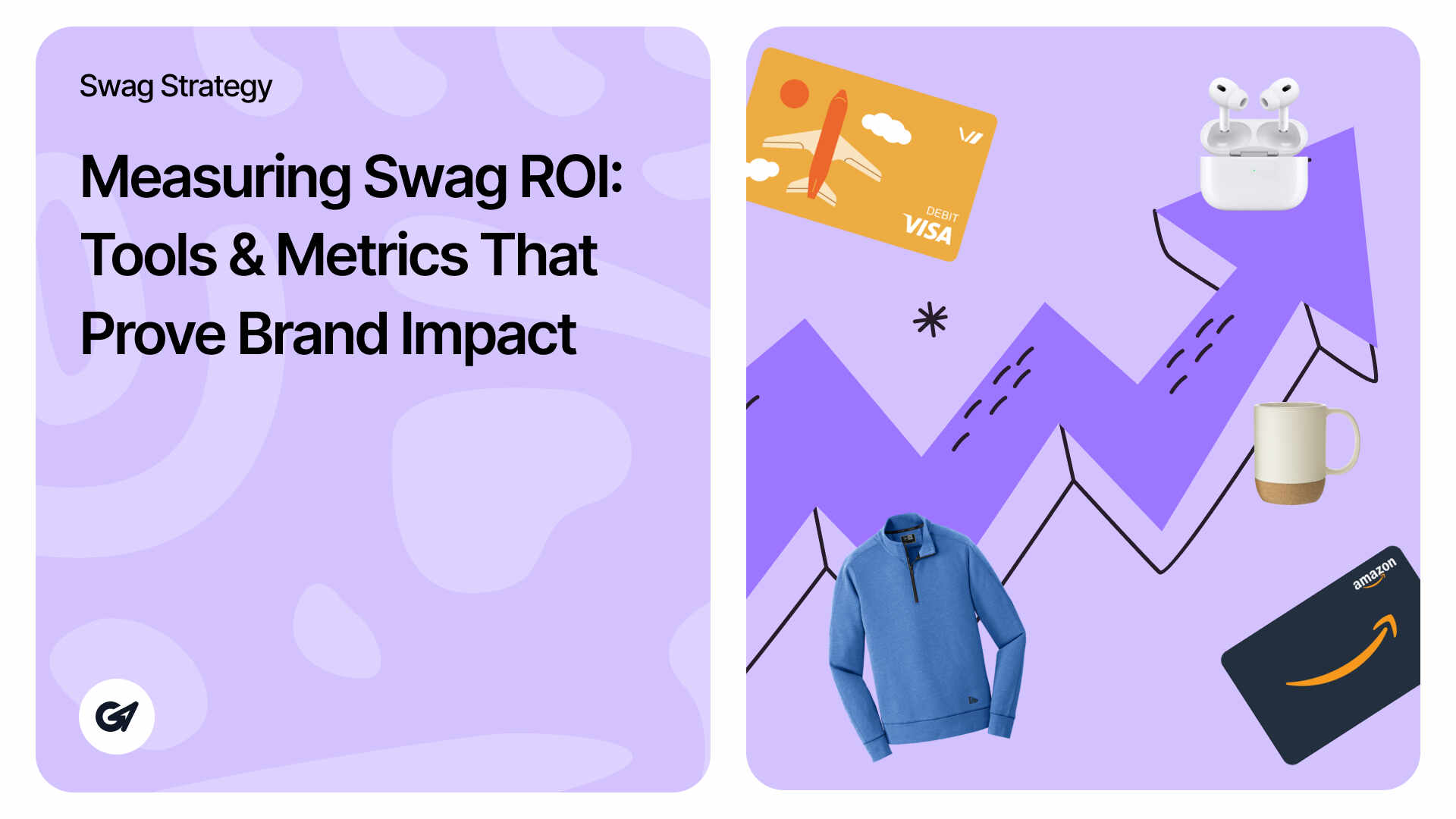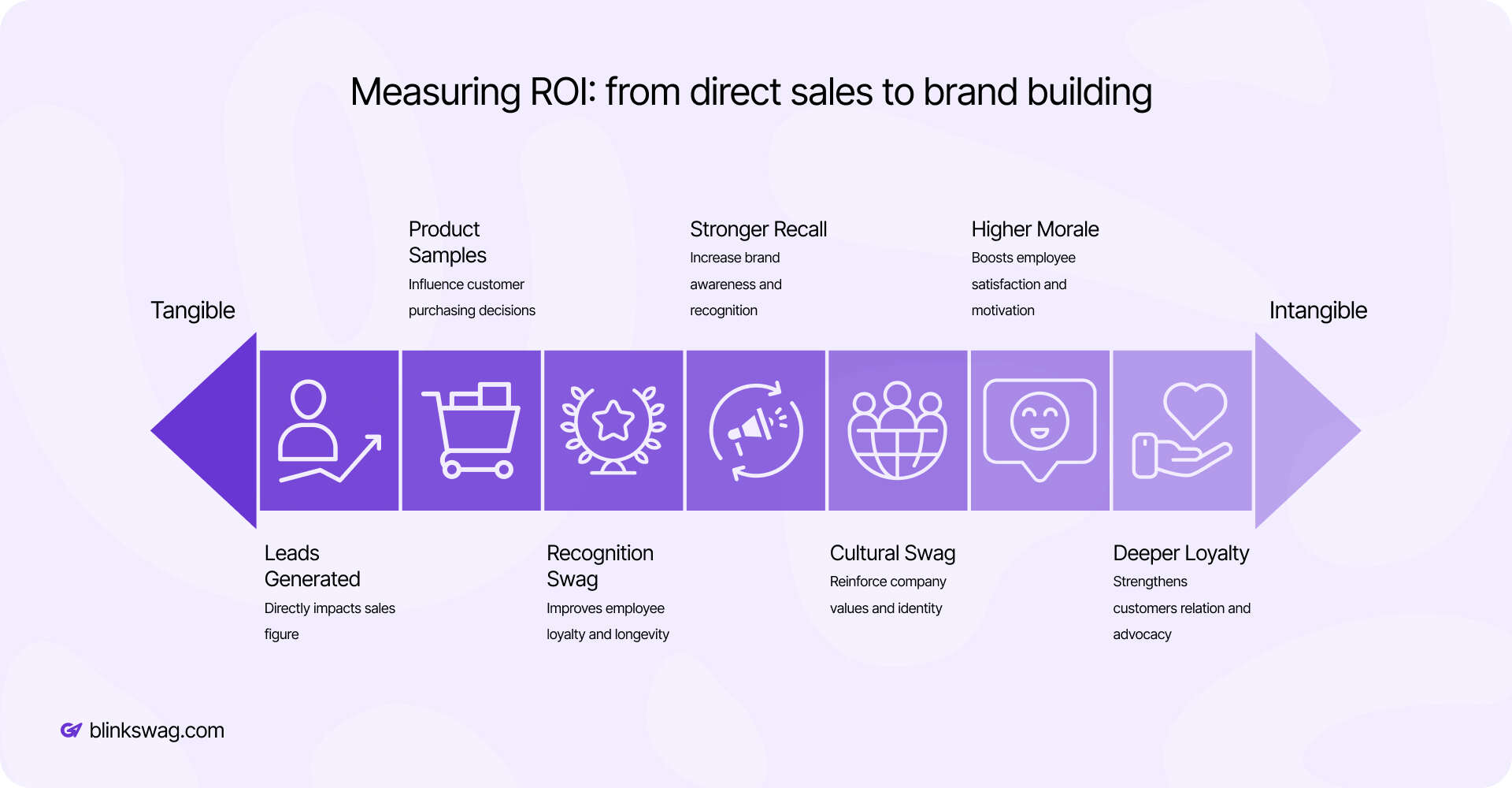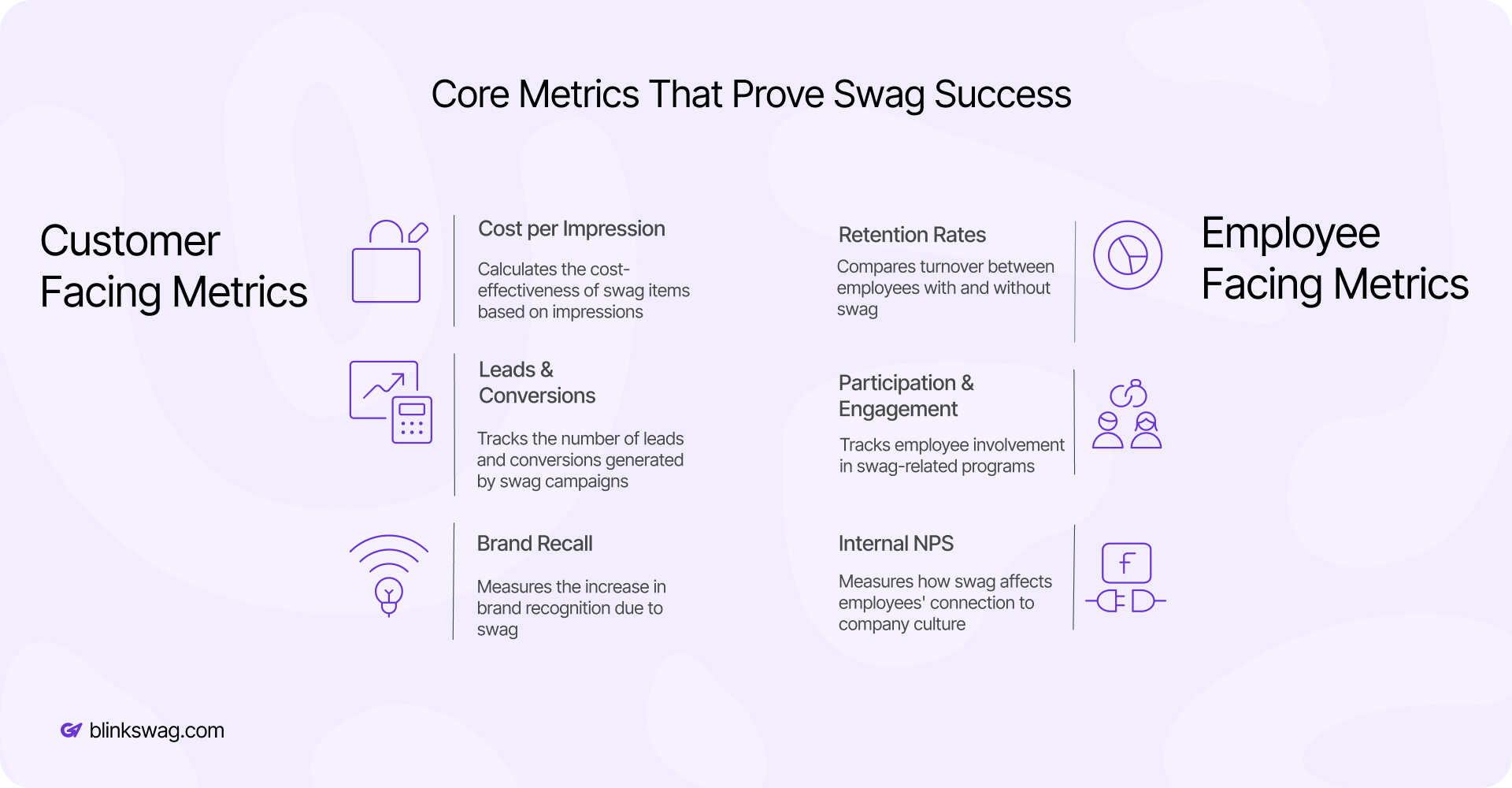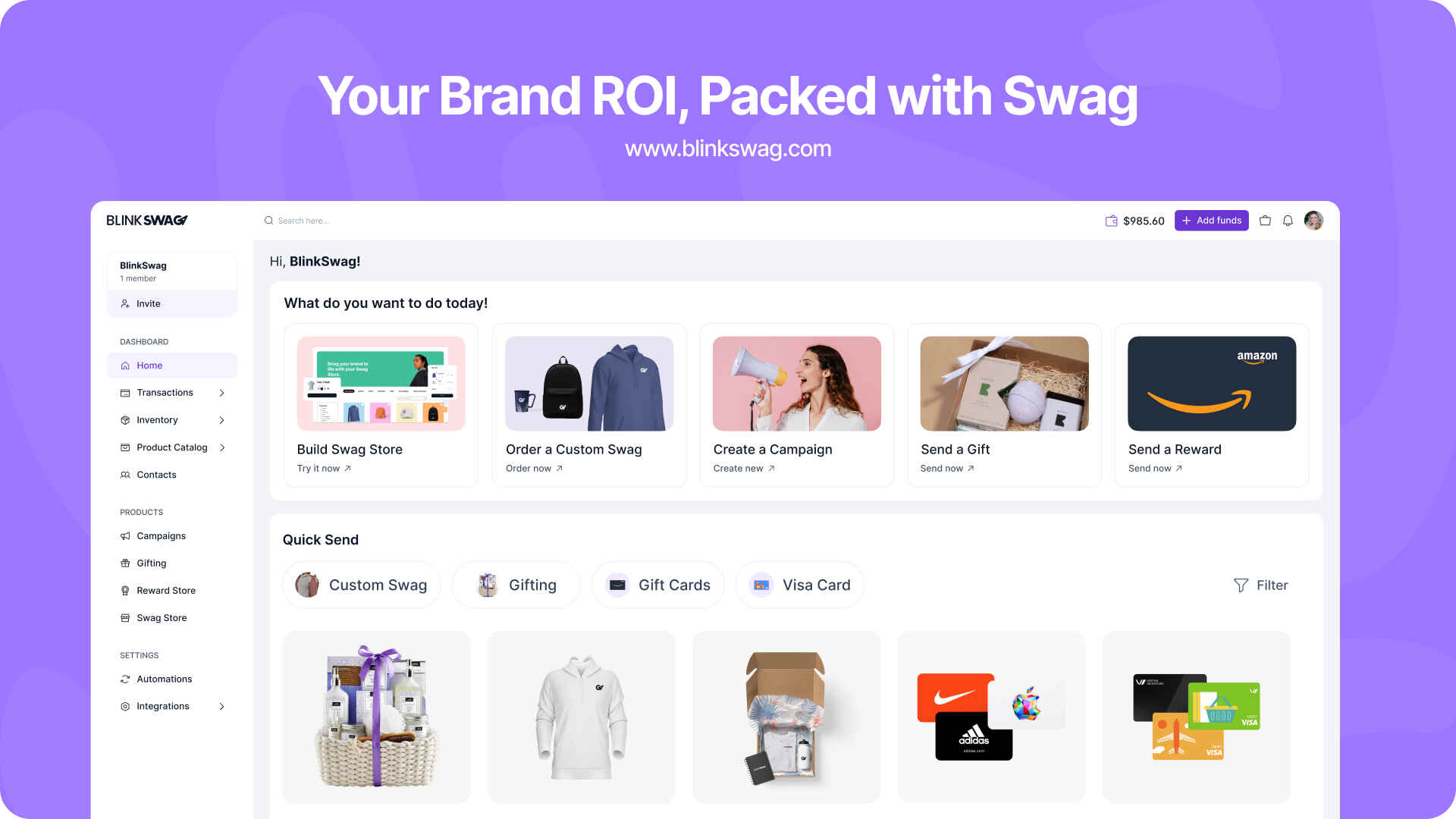Spring Swag is Here!-Check out What’s new

Measuring Swag ROI: Tools & Metrics That Prove Brand Impact
Why Measuring Swag ROI Matters
Every marketing and HR leader has felt the same frustration: thousands of dollars go into branded merchandise, boxes get shipped, and everyone assumes it made an impact. Then the CFO asks the dreaded question: “What did we get in return?”
For too long, swag was treated as a “soft” spend — something you hoped would inspire loyalty or boost morale but rarely measured. The reality is different: when managed correctly, swag can deliver ROI as tangible as digital ads, loyalty programs, or incentive bonuses. The difference lies in whether you track it.
Companies that measure swag ROI don’t just defend their budgets — they unlock insights about what motivates employees, what delights customers, and what drives long-term loyalty.
Defining ROI for Branded Merchandise

Before you can measure ROI, you need to define what success looks like. With swag, the return isn’t always as simple as a sales number — it’s layered across impressions, retention, and brand affinity.
- Tangible ROI: Leads generated from event giveaways, sales conversion influenced by product samples, and employee retention improvements from recognition swag.
- Intangible ROI: Stronger brand recall, cultural alignment, higher employee morale, deeper customer loyalty.
Think of it like this: a branded jacket given to a top performer doesn’t just cost $60. It tells the employee, “You belong here.” That emotional connection can influence whether they stay another year — an outcome with real, measurable financial value.
Swag ROI = Cost of Merchandise + Fulfillment vs. Value of Engagement, Retention, and Loyalty Gained.
Core Metrics That Prove Swag Success ROI for Branded Merchandise
Measuring swag ROI means moving beyond “people liked it” and tracking data points that show actual impact. The best-performing teams use a mix of customer-facing and employee-facing metrics.

Customer-Facing Metrics
- Cost per Impression (CPI): Divide total spend by estimated impressions. Example: A $10 reusable tote used 100 times = 10¢ per impression.
- Leads & Conversions: How many demo requests, sign-ups, or sales can be attributed to swag campaigns?
- Brand Recall: Post-event surveys and digital tracking (via QR codes or URLs) measure whether swag boosted recognition.
Employee-Facing Metrics
- Retention Rates: Compare turnover between employees recognized with swag and those without.
- Participation & Engagement: Track how many employees join wellness challenges or recognition programs tied to swag.
- Internal NPS (Net Promoter Score): Ask employees if company swag makes them feel more connected to the culture.
Sample Swag ROI Metrics Table
Metric | How It’s Measured | Why It Matters | Example |
Cost per Impression (CPI) | Total spend ÷ estimated uses/impressions | Shows cost efficiency vs. ads | $5 tote, used 100x → $0.05 CPI |
Redemption Rate | # of items redeemed ÷ # distributed | Gauges engagement & desirability | 80% of QR-linked hoodies redeemed |
Participation Rate | % of employees/customers joining the program | Tracks campaign reach | 65% joined a swag-based wellness challenge |
Retention Rate Impact | Compare turnover with swag incentives vs. without | Ties swag to HR KPIs | 15% lower turnover in recognized teams |
Brand Recall Uplift | Surveys & recognition tracking | Proves intangible brand impact | 70% recall brand after event vs. 40% baseline |
This data-driven approach proves that swag isn’t just “stuff” — it’s a strategic asset that, when measured properly, validates its role in employee programs and customer campaigns alike.
Tools That Help Track Swag ROI
Gone are the days of spreadsheets and guesswork. Today, modern swag platforms and analytics tools make ROI tracking seamless:
- Swag Management Platforms (like BlinkSwag): Automate distribution, tie orders to events or milestones, and capture redemption data.
- Survey & Feedback Tools: Use platforms like CultureAmp or Qualtrics to collect employee sentiment post-swag campaigns.
- QR Codes & Custom URLs: Track digital engagement by attaching a unique link to each swag item.
- CRM/HRIS Integrations: Connect swag sends directly to Salesforce, BambooHR, or Workday to monitor the impact on deals closed or employee lifecycle events.
The magic happens when swag data doesn’t sit in a silo but becomes part of the broader marketing and HR performance dashboard.
Benchmarks: What Good Swag ROI Looks Like
One question every leader asks: “What counts as success?” Benchmarks will vary, but here’s what industry averages look like:
- Cost per Impression (CPI): Between $0.003–$0.08, often cheaper than digital ads.
- Redemption Rate: Strong campaigns see 70–90% redemption of digital-linked swag.
- Employee Retention Uplift: Swag recognition programs often reduce turnover by 10–20%.
- Customer Engagement: Swag with built-in calls-to-action (QR scans, app downloads) can deliver conversion rates 2–3x higher than traditional promos.
If your numbers fall short, it’s less about spending more and more and more about refining targeting, timing, and item relevance.
Case Scenario: Measuring Impact in Action
Imagine a SaaS company launching a new product. They replace generic event giveaways with a curated swag pack: branded notebooks, eco-friendly bottles, and a QR-coded discount card.
What they tracked:
- CPI dropped from $0.12 (digital ads) to $0.04 (swag impressions).
- 82% of QR codes were scanned, leading to demo requests.
- Customer surveys showed a 25% uplift in brand recall.
On the employee side, the same company tied milestone swag to tenure recognition. Within 12 months, retention improved by 18%, saving hundreds of thousands in rehiring costs.
This is swag ROI in action: not fluff, but business outcomes tied to strategy.
The BlinkSwag Difference: Turning Swag Into a Measurable Asset
Most vendors stop at shipping products. BlinkSwag goes further:

- Built-In Analytics: Track redemption, engagement, and feedback in one dashboard.
- Global Fulfillment: Send anywhere without losing visibility.
- Integrations That Matter: Plug directly into Salesforce, Workday, Gusto, and more.
- Tiered Programs: Align costs to milestones so every reward is purposeful, not random.
With BlinkSwag, swag shifts from “nice to have” to a scalable ROI-driven solution that both HR and marketing teams can defend and expand. Ready to see how BlinkSwag makes swag measurable? Book a quick demo today.
Frequently Asked Questions
How do I calculate ROI for swag campaigns?
Divide the total cost of swag (items, packaging, fulfillment) by the measurable outcomes it drove — impressions, leads, retention savings, or conversions. BlinkSwag provides built-in calculators to simplify this.
What’s the most cost-effective swag?
Items with repeated use and visibility, like drinkware, totes, or tech accessories. These create a lower CPI compared to one-time items.
Can swag ROI be compared to digital ads?
Yes. Swag often has a lower cost per impression and creates longer-lasting engagement. The difference is that swag is both a marketing and culture-building tool.
How can I tie swag ROI to employee engagement?
Track recognition programs through HRIS integration. Look at retention rates, internal NPS, and participation in incentive challenges linked to swag.
Conclusion: Prove It, Improve It
Swag should never be dismissed as un-measurable. It becomes a powerful driver of brand impact, loyalty, and retention when tied to clear goals, tracked through modern tools, and benchmarked correctly.
With BlinkSwag, you’re not guessing about ROI — you’re proving it. And once you prove it, you can scale it with confidence.